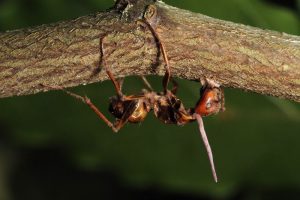BY CADE OOST | SQ ONLINE REPORTER | SQ ONLINE (2015-16)
With Season 7 of “The Walking Dead” closing on a shocking note, and Season 2 of its Southern California prequel “Fear The Walking Dead” underway, it’s safe to say that viewers everywhere are sufficiently scared of the zombies that made the hit shows so successful. But at the end of each episode, we get to take a deep breath, get off the couch, and bite our nails for another week as we wait for the next one to arrive. However, new studies show that some animals don’t get a week long break from zombies like we do, but instead go on about their daily lives vigilantly on watch for their infected brethren.
This is the case for carpenter ants in tropical rainforests across Thailand and Brazil, as well as many other species who face a “zombie threat” from an unlikely enemy. In most stories, zombies are the result of a viral infection, whereas in real life, the culprit is the parasitic fungus Ophiocordyceps Unilateralis, colloquially known as the “zombie-ant fungus.” When the spores of this fungus infect an ant, they release a chemical cocktail specially designed to manipulate its behavior. The ant begins to act erratically and, once fully infected, climbs up a tree searching for an ideal environment for the fungus to grow. When it finds the perfect location, it latches onto a branch and dies. Once the ant is dead, the fungus overtakes its body and grows out of it, eventually erupting and sending spores below to infect more ants.

As scary as it sounds, new studies are showing that this parasitic relationship is relatively common in the natural world. For example, a species of Costa Rican wasp has been observed brainwashing certain spiders into creating a web to support the cocoon of the wasp larva before being eaten by the larva once they hatch. Similarly, hairworms have been shown to insert themselves into the bodies of crickets and chemically manipulate them into drowning themselves in water, where the fully grown hairworm can complete its life cycle. Whether fungal or not, each parasite induces a zombie-like state in its victims by chemically influencing the nervous systems of their hosts, and new studies are suggesting that this is done by producing specific proteins and neurotransmitters similar to those of the host, which effectively trick the host into behaving however the parasite wants it to.
This is only possible through extensive coevolution between parasite and host, and for that reason each parasite, whether fungal or not, is especially designed to infect their specific host species. Studies involving the zombie ant fungus O. Unilateralis showed that while it killed most of the ants it came into contact with, it only performed its signature mind control trick on the select species that it has been known to infect in the wild. Scientists hypothesize that this occurs because the fungus has failed to evolve the right chemical cocktail to hijack the nervous systems of other ant species.
There’s still much to learn about the mechanisms of this chemical brainwashing and its evolution, and researchers like Ryan Hechinger, associate professor at the Scripps Institute of Oceanography, continue to look for clues pertaining specifically to how ecology and evolution play into these fascinating and extremely unique parasite-host dynamics.
[hr gap=”0″]
Sources:
- http://www.livescience.com/46116-parasitic-wasp-turns-roaches-into-zombie-slaves-using-neurotoxic-cocktail.html?li_source=LI&li_medium=more-from-livescience
- http://www.livescience.com/47751-zombie-fungus-picky-about-ant-brains.html
- http://news.nationalgeographic.com/news/2012/05/120504-zombie-ant-fungus-science-environment-rainforest/
- http://www.techtimes.com/articles/14135/20140827/zombie-ants-controlled-by-fungus-manipulating-brains.htm
- http://www.livescience.com/34196-zombie-animals.html
- http://news.nationalgeographic.com/news/2014/10/141031-zombies-parasites-animals-science-halloween/
- http://scrippsscholars.ucsd.edu/rhechinger